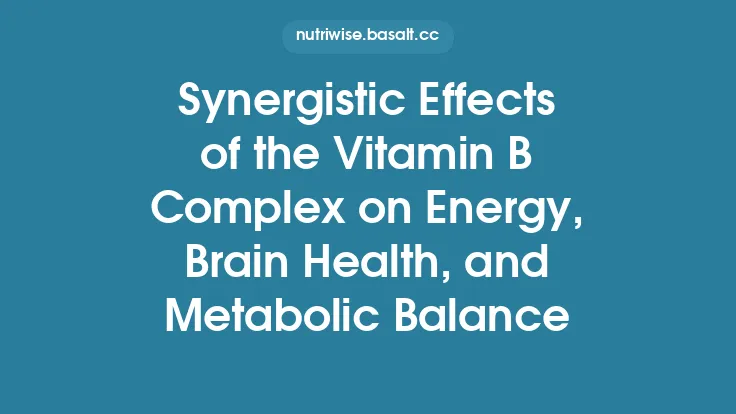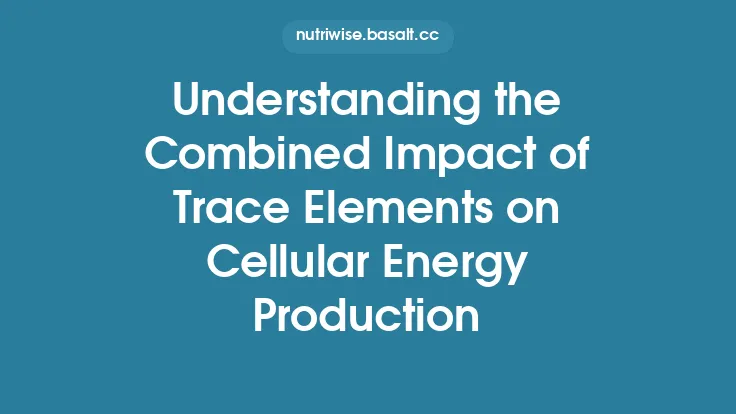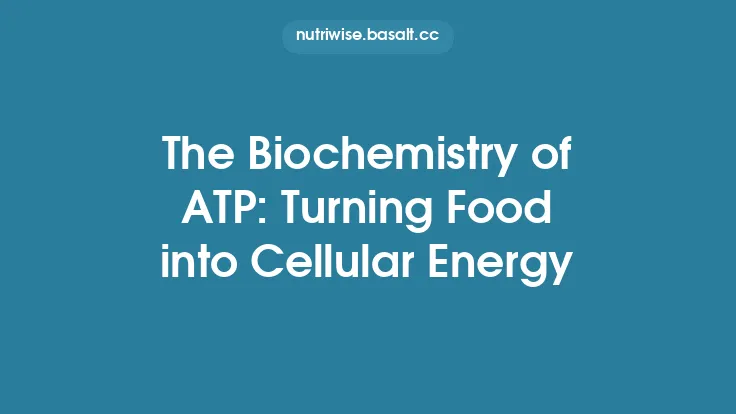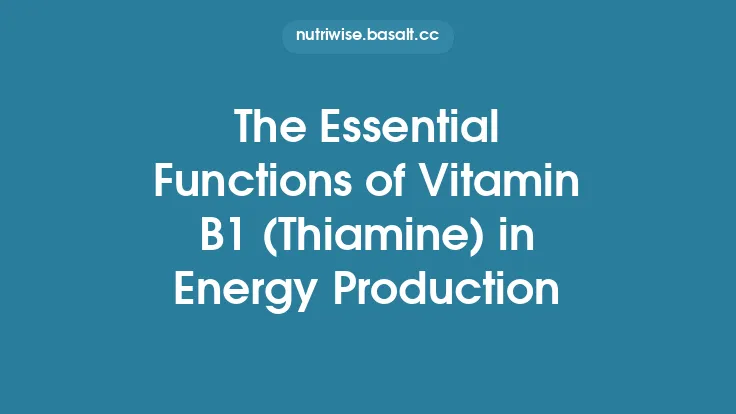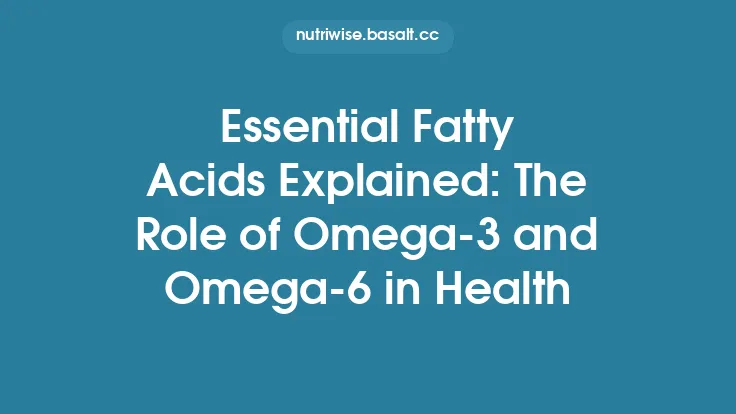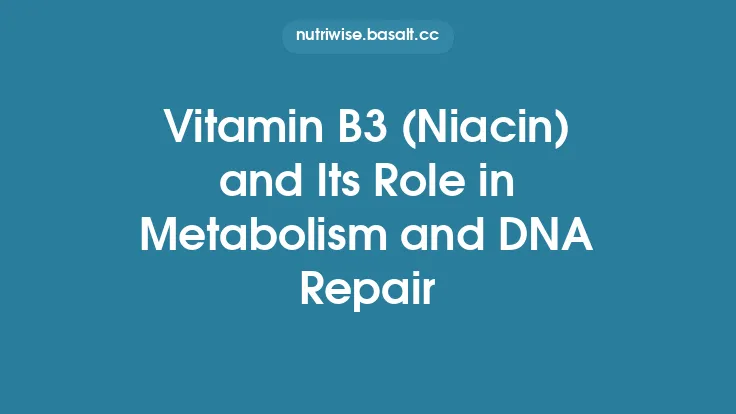The digestion of the foods we eat ultimately fuels every cellular process, and at the heart of this energy conversion lie two ubiquitous redox couples: NAD⁺/NADH and FAD/FADH₂. Although they are often mentioned in passing when describing metabolic pathways, their biochemical properties, sources, and regulatory roles are far more nuanced than a simple “electron carrier” label suggests. Understanding how these cofactors are generated from dietary nutrients, how they shuttle reducing equivalents, and how their cellular pools are maintained provides a deeper appreciation of the metabolic choreography that sustains life.
Redox Chemistry of NAD⁺/NADH and FAD/FADH₂
Both NAD⁺ (nicotinamide adenine dinucleotide) and FAD (flavin adenine dinucleotide) are derived from B‑vitamin precursors and function as two‑electron carriers. Their redox potentials are finely tuned to accept electrons from a wide variety of catabolic reactions and to donate them to downstream acceptors, most notably the mitochondrial electron transport chain (ETC).
- NAD⁺/NADH
- Structure: Consists of two nucleotides joined through their phosphate groups; the nicotinamide moiety is the redox‑active site.
- Redox potential: Approximately –0.32 V (standard conditions), making NAD⁺ a strong oxidizing agent for many dehydrogenases.
- Electron transfer: Accepts a hydride ion (H⁻) – two electrons and one proton – while releasing a second proton into the medium, yielding NADH + H⁺.
- FAD/FADH₂
- Structure: A flavin ring (derived from riboflavin) linked to an adenine dinucleotide. The isoalloxazine ring can undergo two sequential one‑electron reductions, but in most metabolic contexts it functions as a two‑electron carrier, forming FADH₂.
- Redox potential: Roughly –0.22 V, slightly less negative than NAD⁺, which influences the amount of ATP generated per molecule when electrons are passed to the ETC.
- Electron transfer: Accepts two electrons and two protons, producing fully reduced FADH₂.
Because of these intrinsic properties, NAD⁺ and FAD differ in the “energy value” of the electrons they deliver: oxidation of NADH typically yields ~2.5 ATP equivalents, whereas oxidation of FADH₂ yields ~1.5 ATP equivalents. This distinction is a key factor in the overall efficiency of nutrient oxidation.
Sources of NAD⁺ and FAD Precursors in the Diet
The body cannot synthesize the vitamin backbones of these cofactors de novo; they must be obtained from the diet or salvaged from endogenous turnover.
| Cofactor | Primary Dietary Precursors | Typical Food Sources | Absorption & Conversion |
|---|---|---|---|
| NAD⁺ | Niacin (nicotinic acid, nicotinamide) and tryptophan (via the kynurenine pathway) | Meat, fish, poultry, legumes, nuts, fortified cereals, coffee | Niacin is absorbed as nicotinic acid or nicotinamide, then phosphorylated to NAD⁺. Tryptophan contributes ~60 mg of niacin equivalents per 1 g of tryptophan. |
| FAD | Riboflavin (vitamin B₂) | Dairy products, eggs, leafy greens, almonds, mushrooms, fortified breads | Riboflavin is taken up by intestinal transporters, phosphorylated to FMN, then adenylated to FAD by FAD synthetase. |
Both vitamins are water‑soluble, and excess amounts are excreted in urine, which underscores the importance of regular dietary intake to sustain optimal cofactor pools.
Generation of NADH and FADH₂ During Nutrient Catabolism
When macronutrients are broken down into their constituent carbon skeletons, a series of dehydrogenase reactions liberate electrons that are captured by NAD⁺ or FAD. While the specific enzymes differ among carbohydrates, fatty acids, and amino acids, the overarching principle is the same: oxidation of a substrate reduces the cofactor, storing the energy of the carbon–hydrogen bond in a high‑energy electron pair.
- Carbohydrate‑derived carbon: After glycolytic cleavage of glucose (or the equivalent processing of maltose, sucrose, etc.), the resulting three‑carbon intermediates are further oxidized in the cytosol and mitochondria, generating NADH at key steps such as the conversion of glyceraldehyde‑3‑phosphate to 1,3‑bisphosphoglycerate. Although the detailed glycolytic pathway is covered elsewhere, the essential point is that each glucose molecule ultimately yields multiple NADH molecules that will later feed the ETC.
- Fat‑derived carbon: β‑oxidation of fatty acyl‑CoA chains produces one NADH and one FADH₂ per two‑carbon unit removed. The FAD‑dependent step (formation of a trans‑Δ²‑enoyl‑CoA) is catalyzed by acyl‑CoA dehydrogenases, which directly reduce FAD to FADH₂. The subsequent dehydrogenation step reduces NAD⁺ to NADH. Even without delving into the full β‑oxidation cycle, it is clear that dietary fats are a rich source of both reduced cofactors.
- Protein‑derived carbon: Deamination of amino acids yields α‑keto acids that enter various oxidative pathways. Many of these dehydrogenations are NAD⁺‑dependent (e.g., the conversion of glutamate to α‑ketoglutarate). Some catabolic routes, such as the oxidation of certain branched‑chain amino acids, involve FAD‑dependent enzymes.
Collectively, the catabolism of a mixed diet supplies a balanced mixture of NADH and FADH₂, which is crucial for maintaining the appropriate electron flow into the ETC.
Integration Into the Electron Transport Chain
The mitochondrial inner membrane houses a series of protein complexes (I–IV) and mobile carriers (ubiquinone, cytochrome c) that constitute the ETC. NADH and FADH₂ deliver their electrons to this chain, but they enter at distinct points, influencing the overall proton‑pumping efficiency.
- Complex I (NADH:ubiquinone oxidoreductase):
- Receives electrons from NADH via a flavin mononucleotide (FMN) prosthetic group.
- Couples electron transfer to the translocation of four protons across the inner membrane per NADH oxidized.
- Complex II (succinate dehydrogenase):
- Accepts electrons from FADH₂ (generated in the oxidation of succinate or fatty acyl‑CoA).
- Unlike Complex I, Complex II does not pump protons; it merely passes electrons to ubiquinone.
- Ubiquinone (Coenzyme Q):
- Serves as a lipid‑soluble electron shuttle, accepting electrons from both Complex I (via NADH) and Complex II (via FADH₂).
- Complexes III and IV:
- Further transfer electrons to cytochrome c and ultimately to molecular oxygen, driving the translocation of additional protons (six at Complex III, two at Complex IV per pair of electrons).
The differential proton‑pumping capacity explains why oxidation of NADH yields roughly 2.5 ATP, while oxidation of FADH₂ yields about 1.5 ATP. The balance of NADH versus FADH₂ generated from the diet therefore directly influences the energetic yield of cellular respiration.
Regulation of the Cellular NAD⁺/NADH Ratio
The ratio of oxidized to reduced nicotinamide adenine dinucleotide is a central metabolic gauge. Cells maintain this ratio within a narrow window (typically 5–10 in the cytosol, 3–7 in mitochondria) through several mechanisms:
- Respiratory flux: Rapid oxidation of NADH by the ETC lowers the NADH pool, preserving a high NAD⁺/NADH ratio. When oxygen availability declines, the ratio drops, signaling a shift toward anaerobic pathways (e.g., lactate production).
- NAD⁺ salvage pathways: Enzymes such as nicotinamide phosphoribosyltransferase (NAMPT) recycle nicotinamide back to NAD⁺, ensuring a steady supply even when dietary niacin is limited.
- Compartmentalization: Distinct NAD⁺/NADH pools exist in the cytosol, mitochondria, and nucleus, each regulated by specific transporters (e.g., the mitochondrial NAD⁺ carrier SLC25A51).
- Allosteric regulation of dehydrogenases: Many NAD⁺‑dependent enzymes are inhibited by high NADH concentrations, providing feedback control that throttles upstream catabolism when the electron transport chain is saturated.
These regulatory layers allow the cell to adapt quickly to changes in nutrient intake, oxygen tension, and energy demand.
Physiological Implications of NAD⁺ and FAD Availability
Beyond their role in ATP synthesis, the redox state of NAD⁺/NADH and FAD/FADH₂ influences a host of physiological processes:
- Metabolic flexibility: A robust NAD⁺ pool enables rapid switching between carbohydrate and fat oxidation because NAD⁺‑dependent dehydrogenases can operate efficiently regardless of substrate.
- Oxidative stress management: NAD⁺ is a substrate for poly(ADP‑ribose) polymerases (PARPs) and sirtuins, enzymes that consume NAD⁺ during DNA repair and deacetylation, respectively. Depletion of NAD⁺ can impair these protective pathways, linking redox balance to cellular longevity.
- Mitochondrial biogenesis: Sirtuin‑1 (SIRT1) activity, which depends on NAD⁺, deacetylates transcriptional coactivators such as PGC‑1α, promoting the formation of new mitochondria and enhancing oxidative capacity.
- Immune function: Certain immune cells (e.g., activated macrophages) shift toward a more reduced NADH state, influencing cytokine production and the inflammatory response.
- Aging and disease: Declining NAD⁺ levels are observed in aging tissues and in metabolic disorders such as type 2 diabetes and neurodegeneration. Restoring NAD⁺ through dietary precursors (nicotinamide riboside, nicotinamide mononucleotide) is an active area of research.
FAD, while less frequently highlighted, is equally important for the activity of flavoprotein enzymes involved in fatty acid oxidation, the catabolism of certain amino acids, and the detoxification of reactive oxygen species (e.g., via glutathione reductase, which uses FAD as a cofactor).
Interplay With Cellular Signaling and Longevity Pathways
The redox couples intersect with several signaling cascades that extend far beyond pure energy metabolism:
- Sirtuin signaling: As noted, NAD⁺‑dependent deacetylases (SIRT1‑7) modulate transcription factors, metabolic enzymes, and mitochondrial proteins. Their activity is directly proportional to the NAD⁺/NADH ratio, making NAD⁺ a “metabolic rheostat.”
- AMP‑activated protein kinase (AMPK): While AMPK primarily senses AMP/ATP ratios, its activation can be potentiated by an elevated NAD⁺/NADH ratio, which promotes catabolic pathways that generate ATP.
- Hypoxia‑inducible factor (HIF): Under low oxygen, NADH accumulates, stabilizing HIF‑α subunits and shifting gene expression toward glycolysis and angiogenesis.
- Redox‑dependent transcription factors: NF‑κB and Nrf2 are modulated by the cellular redox environment; NADPH (derived from the pentose phosphate pathway) supplies reducing power for antioxidant defenses, but the NAD⁺/NADH balance indirectly influences these pathways by affecting overall redox homeostasis.
Collectively, these interactions illustrate how the simple act of oxidizing a nutrient to generate NADH or FADH₂ reverberates through the cell’s regulatory network, influencing healthspan and disease susceptibility.
Practical Dietary Strategies to Support Redox Cofactor Pools
Given the centrality of NAD⁺ and FAD in energy transfer, dietary choices can be tailored to maintain optimal cofactor levels:
- Ensure adequate B‑vitamin intake:
- Niacin: Aim for 15–20 mg/day (RDA) from sources like turkey, tuna, peanuts, and fortified grains.
- Riboflavin: Target 1.1–1.3 mg/day (RDA) via dairy, eggs, and leafy vegetables.
- Incorporate NAD⁺ precursors:
- Nicotinamide riboside (NR) and nicotinamide mononucleotide (NMN) are emerging supplements that bypass the rate‑limiting steps of the salvage pathway, directly boosting NAD⁺ levels.
- Balance macronutrient composition:
- A mixed diet of carbohydrates, healthy fats, and lean proteins provides a balanced supply of NADH and FADH₂, supporting both high‑yield (NADH) and moderate‑yield (FADH₂) electron inputs.
- Limit chronic over‑nutrition:
- Excess caloric intake can lead to mitochondrial overload, causing a relative increase in NADH and a drop in the NAD⁺/NADH ratio, which may impair sirtuin activity and promote insulin resistance.
- Consider intermittent fasting or time‑restricted eating:
- Periods of low nutrient availability naturally elevate the NAD⁺/NADH ratio, enhancing sirtuin signaling and mitochondrial turnover.
- Support gut health:
- Certain gut microbes synthesize B‑vitamins; a diverse microbiome can contribute to systemic NAD⁺ and FAD availability.
By integrating these practices, individuals can help preserve the redox balance essential for efficient energy transfer and overall metabolic health.
Concluding Perspective
NAD⁺/NADH and FAD/FADH₂ are far more than passive electron shuttles; they are dynamic integrators of dietary input, cellular respiration, and signaling networks that together dictate how effectively the body converts food into usable energy. Their origins trace back to the vitamins we ingest, their reduction occurs during the oxidation of carbohydrates, fats, and proteins, and their oxidation powers the mitochondrial machinery that ultimately produces ATP. Moreover, the ratios of these cofactors serve as metabolic barometers, influencing pathways that govern stress resistance, mitochondrial biogenesis, and even the aging process.
A comprehensive appreciation of these redox couples underscores the importance of a nutrient‑rich, balanced diet and highlights emerging nutritional interventions—such as NAD⁺ precursor supplementation—that aim to sustain cellular vitality. As research continues to unravel the nuanced roles of NAD⁺ and FAD in health and disease, the age‑old adage “you are what you eat” gains a new, molecular dimension: the foods we consume shape the very redox landscape that powers every heartbeat, thought, and movement.
